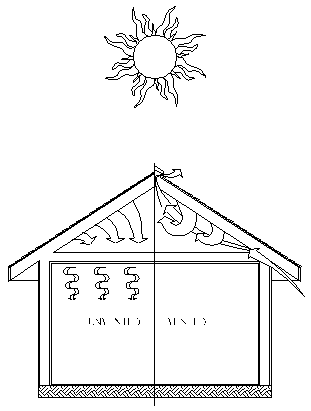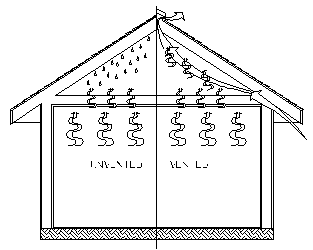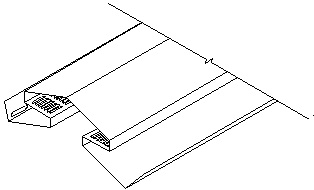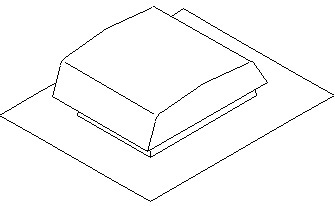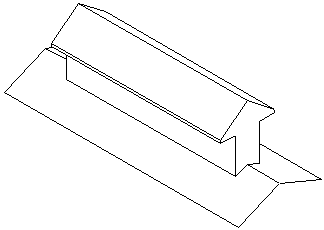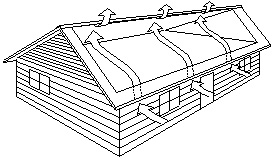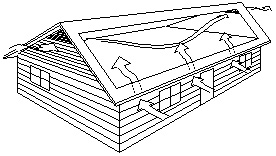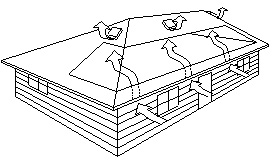Difference between revisions of "Building Ventilation"
Difference between revisions of "Building Ventilation"
(→Attic and Roof Space Ventilation) |
|||
| (15 intermediate revisions by the same user not shown) | |||
| Line 1: | Line 1: | ||
| − | + | {{Template:RPM Info}} | |
| − | |||
| + | {{DISPLAYTITLE:<span style="position: absolute; clip: rect(1px 1px 1px 1px); clip: rect(1px, 1px, 1px, 1px);">{{FULLPAGENAME}}</span>}} | ||
| + | __NOTOC__ | ||
| − | === | + | <big><big>Division E - General Information</big></big> |
| + | <hr> | ||
| + | <big><big><big><big><big>Building Ventilation</big></big></big></big></big> | ||
| + | {| class="wikitable" | style="color: black; background-color: #ffffcc; width: 100%;" | ||
| + | | colspan="2" | '''NOTICE TO READER''': This is an <u>information page only</u>. To read the standards applicable to a particular Waterproofing or Water-shedding System, refer to the actual Standard located in [[Division B | '''Division B''']]. | ||
| + | |} | ||
| + | |||
| + | <big><big><big>General</big></big></big> | ||
| + | |||
| + | This section of the RCABC '''''Roofing Practices Manual''''' provides general information on the benefits, types of vents and BC Building Code Requirements for attic and roof space ventilation. The Reader is urged to consult all relevant codes governing construction design and practices in any given jurisdiction. | ||
| + | |||
| + | <big><big><big>Benefits of Attic Ventilation</big></big></big> | ||
{| class="wikitable" style="vertical-align:top; margin-left:20pt; margin-right:auto; border:none;" | {| class="wikitable" style="vertical-align:top; margin-left:20pt; margin-right:auto; border:none;" | ||
| Line 17: | Line 29: | ||
|} | |} | ||
| − | + | <big><big>Types of Pitched Roof Attic Vents</big></big> | |
<table border=0 cellpadding=3 cellspacing=0 width=500> | <table border=0 cellpadding=3 cellspacing=0 width=500> | ||
| Line 45: | Line 57: | ||
</table> | </table> | ||
| − | + | ||
| + | <big><big>Attic and Roof Space Ventilation</big></big> | ||
Requirements for Residential and Small Buildings (BC Building Code Section 9.19) | Requirements for Residential and Small Buildings (BC Building Code Section 9.19) | ||
{| class="wikitable" style="vertical-align:top; margin-left: 20pt; margin-right: auto; border: none;" | {| class="wikitable" style="vertical-align:top; margin-left: 20pt; margin-right: auto; border: none;" | ||
| − | |+ Ridge and | + | |+ Ridge, Soffit and Gable Ventilation |
|- | |- | ||
! style="width:500px;"| Continuous Ridge Vent and Soffit Ventilation | ! style="width:500px;"| Continuous Ridge Vent and Soffit Ventilation | ||
| Line 64: | Line 77: | ||
| style="text-align:center;" | Spaced Purlins provide air space || | | style="text-align:center;" | Spaced Purlins provide air space || | ||
|- | |- | ||
| − | | style="text-align:center;" | [[File: | + | | style="text-align:center;" | [[File:CathedralCeiling.jpg]] || style="text-align:center;" | [[File:RoofAirVentsandSoffit.jpg]] |
|- | |- | ||
| style="text-align:left;" | Where each joist space is not separately vented, roof joist spaces shall be interconnected by installing purlins not less than 38 mm (1 1/2 ”) by 38 mm (1 1/2 ”) on top of the roof joists. Not less than 63 mm (2 1/2 ”) of space shall be provided between the top of the insulation and the underside of the roof sheathing. || Vents may be roof, eave or gable end type or any combination thereof, as long as adequate ventilation is provided. The vents must be distributed uniformly on opposite sides of the building. Not less than 25% of required vent openings shall be located at the top of the attic or roof space, and not less than 25% of the required openings shall be located at the bottom of the space. The lower portion of the mansard or gambrel style roofs does not need to be ventilated. The upper portion requires ventilation as noted above. | | style="text-align:left;" | Where each joist space is not separately vented, roof joist spaces shall be interconnected by installing purlins not less than 38 mm (1 1/2 ”) by 38 mm (1 1/2 ”) on top of the roof joists. Not less than 63 mm (2 1/2 ”) of space shall be provided between the top of the insulation and the underside of the roof sheathing. || Vents may be roof, eave or gable end type or any combination thereof, as long as adequate ventilation is provided. The vents must be distributed uniformly on opposite sides of the building. Not less than 25% of required vent openings shall be located at the top of the attic or roof space, and not less than 25% of the required openings shall be located at the bottom of the space. The lower portion of the mansard or gambrel style roofs does not need to be ventilated. The upper portion requires ventilation as noted above. | ||
| Line 70: | Line 83: | ||
|} | |} | ||
| − | + | </div><!-- mainBodyDiv --> | |
| + | </div><!-- row --> | ||
| + | <div class="col-md-12"> | ||
<hr> | <hr> | ||
| + | [[Main Page | <i class="fa fa-home fa"></i> Home]] | ||
| + | </div> | ||
| − | + | {{Tempate:RPM Page Footer with Copyright and Current Date}} | |
| − | |||
| − | |||
Latest revision as of 15:33, 9 September 2021
Division E - General Information
Building Ventilation
| NOTICE TO READER: This is an information page only. To read the standards applicable to a particular Waterproofing or Water-shedding System, refer to the actual Standard located in Division B. |
General
This section of the RCABC Roofing Practices Manual provides general information on the benefits, types of vents and BC Building Code Requirements for attic and roof space ventilation. The Reader is urged to consult all relevant codes governing construction design and practices in any given jurisdiction.
Benefits of Attic Ventilation
Types of Pitched Roof Attic Vents
Attic and Roof Space Ventilation
Requirements for Residential and Small Buildings (BC Building Code Section 9.19)
© RCABC 2025
RoofStarTM is a registered Trademark of the RCABC.
No reproduction of this material, in whole or in part, is lawful without the expressed permission of the RCABC Guarantee Corp.

